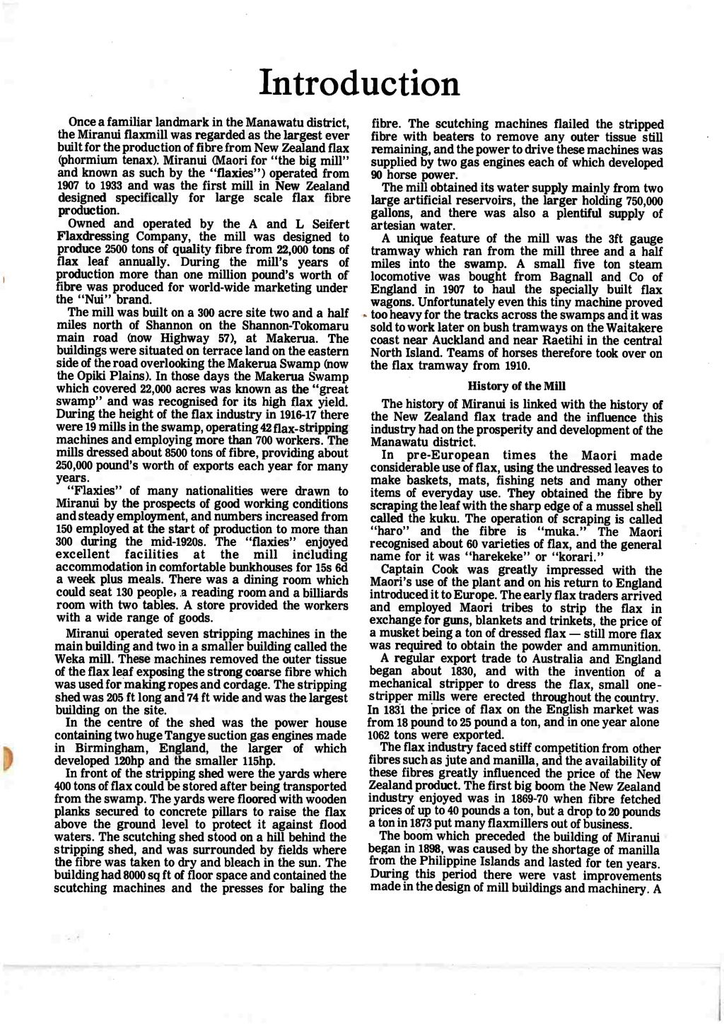Miranui - The story of New Zealand's largest flax mill - page 3
- Description
Owned and operated by the A and L Seifert Flaxdressing Company, the mill was designed to produce 2500 tons of quality fibre from 22,000 tons of flax leaf annually. During the mill's years of production more than one million pound's worth of fibre was produced for world-wide marketing under the "Nui" brand.
The mill was built on a 300 acre site two and a half miles north of Shannon on the Shannon-Tokomaru main road (now Highway 57), at Makerua. The buildings were situated on terrace land on the eastern side of the road overlooking the Makerua Swamp (now the Opiki Plains). In those days the Makerua Swamp which covered 22,000 acres was known as the "great swamp" and was recognised for its high flax yield. During the height of the flax industry in 1916-17 there were 19 mills in the swamp, operating 42 flax-stripping machines and employing more than 700 workers. The mills dressed about 8500 tons of fibre, providing about 250,000 pound's worth of exports each year for many years.
"Flaxies" of many nationalities were drawn to Miranui by the prospects of good working conditions and steady employment, and numbers increased from 150 employed at the start of production to more than 300 during the mid-1920s. The "flaxies" enjoyed excellent facilities at the mill including accommodation in comfortable bunkhouses for 15s 6d a week plus meals. There was a dining room which could seat 130 people, a reading room and a billiards room with two tables. A store provided the workers with a wide range of goods.
Miranui operated seven stripping machines in the main building and two in a smaller building called the Weka mill. These machines removed the outer tissue of the flax leaf exposing the strong coarse fibre which was used for making ropes and cordage. The stripping shed was 205 ft long and 74 ft wide and was the largest building on the site.
In the centre of the shed was the power house containing two huge Tangye suction gas engines made in Birmingham, England, the larger of which developed 124hp and the smaller 115hp.
In front of the stripping shed were the yards where 400 tons of flax could be stored after being transported from the swamp. The yards were floored with wooden planks secured to concrete pillars to raise the flax above the ground level to protect it against flood waters. The scutching shed stood on a hill behind the stripping shed, and was surrounded by fields where the fibre was taken to dry and bleach in the sun. The building had 8000 sq ft of floor space and contained the scutching machines and the presses for baling the fibre. The scutching machines flailed the stripped fibre with beaters to remove any outer tissue still remaining, and the power to drive these machines was supplied by two gas engines each of which developed 90 horse power.
The mill obtained its water supply mainly from two large artificial reservoirs, the larger holding 750,000 gallons, and there was also a plentiful supply of artesian water.
A unique feature of the mill was the 3ft gauge tramway which ran from the mill three and a half miles into the swamp. A small five ton steam locomotive was bought from Bagnall and Co of England in 1907 to haul the specially built flax wagons. Unfortunately even this tiny machine proved too heavy for the tracks across the swamps and it was sold to work later on bush tramways on the Waitakere coast near Auckland and near Raetihi in the central North Island. Teams of horses therefore took over on the flax tramway from 1910.
History of the Mill
The history of Miranui is linked with the history of the New Zealand flax trade and the influence this industry had on the prosperity and development of the Manawatu district.
In pre-European times the Maori made considerable use of flax, using the undressed leaves to make baskets, mats, fishing nets and many other items of everyday use. They obtained the fibre by scraping the leaf with the sharp edge of a mussel shell called the kuku. The operation of scraping is called "haro" and the fibre is "muka." The Maori recognised about 60 varieties of flax, and the general name for it was "harekeke" or "korari."
Captain Cook was greatly impressed with the Maori's use of the plant and on his return to England introduced it to Europe. The early flax traders arrived and employed Maori tribes to strip the flax in exchange for guns, blankets and trinkets, the price of a musket being a ton of dressed flax - still more flax was required to obtain the powder and ammunition.
A regular export trade to Australia and England began about 1830, and with the invention of a mechanical stripper to dress the flax, small onestripper mills were erected throughout the country. In 1831 the price of flax on the English market was from 18 pound to 25 pound a ton, and in one year alone 1062 tons were exported.
The flax industry faced stiff competition from other fibres such as jute and manilla, and the availability of these fibres greatly influenced the price of the New Zealand product. The first big boom the New Zealand industry enjoyed was in 1869-70 when fibre fetched prices of up to 40 pounds a ton, but a drop to 20 pounds a ton in 1873 put many flaxmillers out of business.
The boom which preceded the building of Miranui began in 1898, was caused by the shortage of manilla from the Philippine Islands and lasted for ten years. During this period there were vast improvements made in the design of mill buildings and machinery. A
Identification
- Date
- 1977
Taxonomy
- Community Tags


